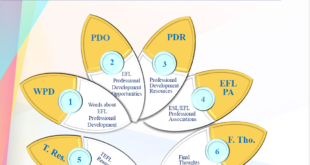استراتيجية جميلة وممتعة جداً مناسبة لطلاب المرحلة الابتدائية
تستخدم فيها الحركة والترديد مع الترفيه لحفظ الكلمات وترسيخها
وسنرفق نبذة كاملة عن الاستراتيجية بالأسفل مع الفيديو
Total Physical Response (TPR)
Total Physical Response (TPR) is a method of teaching language or vocabulary concepts by using physical movement to react to verbal input. The process mimics the way that infants learn their first language, and it reduces student inhibitions and lowers stress. The purpose of TPR is to create a brain link between speech and action to boost language and vocabulary learning
How to Use
1. Prepare
Select the vocabulary that you are going to teach. Gather any equipment, props or pictures you will need to illustrate the meaning of the words.
2. Teacher Modeling
Say the new vocabulary word for the students. As you do this, use gestures, facial expressions, props or body movement to illustrate the meaning of the word.
3. Student Modeling
Have student volunteers mimic the same gestures, facial expressions, use of props or body movement modeled as you say the word.
4. Student Participation
Have all students mimic the same gestures, facial expressions, use of props or body movement modeled by the teacher and student volunteers. Ask them to say the word as they are making the movement. Vary this activity by then doing the action and while students say the word.
5. Writing
Write the word or phrase where all students can see it so that students can make the connection between oral and written words.
6. Repetition and Practice
Teach the next word or phrase using the same method. Review and practice words with students multiple times to ensure learning. Recycle words regularly to make sure that students do not forget old words.
When to Use
Total Physical Response (TPR) may be used to teach many types of vocabulary but works best when teaching vocabulary connected with action. It is an effective strategy to use with English Language Learners as well as with native speakers when learning new words.
Variations
TPR Circles
Organize the students into a circle around the teacher. The teacher says the word and the last person to do the action is out. This person then stands behind the teacher and watches for the student who does the action last. Eventually there is only one student, he or she is the winner.
TPR Simon Says
Play Simon Says. The teacher gives a command and students should only do it if the teacher “Simon says…” at the start. The teacher might say, “Simon says, ‘slice some bread'” or “Simon says, ‘chop an onion'” and the students must do the action. However if the teacher says, “Whisk an egg” the students shouldn’t do this. If anyone does the action that Simon doesn’t say then they are out and have to watch for the mistakes of the other students.
TPR Sounds
The teacher will first get the students to do the actions connected with each vocabulary word. Then, the teacher adds a sound related to the word and the students practice hearing the word and doing the action along with making the sound. The students are then ready to give commands to each other.
http://www.theteachertoolkit.com/index.php/tool/total-physical-response-tpr
https://youtu.be/WXnPDnai1S8
 بلبل English لتعليم اللغة الإنجليزية
بلبل English لتعليم اللغة الإنجليزية



